D1X & D1H: A Day at the Races
| I spent a great weekend shooting the Monterey Historic car races with a D1H and a D1X. I can't imagine two better cameras for the job. First, both cameras produced great color right away and every time. Getting the right color required the usual D1 maneuvering, in this case I shot with Cloudy -3 even though the Sun was blazing--but it helps warm up the heat of the day sunlight. Second, instant image preview on the LCD allows quick compensation. Depending on the exact angle of the light I wound up using either the native matrix metering or compensation up to -1 to keep the highlights from being blown out--on the white race cars in particular. |
|
My initial intent was to determine which camera made the best tool for racing photography, but by the end I was truly torn. The D1X provides an awesome 5.4MPixel image which is perfect for the poster-size reproductions favored for many racing photos. But the D1H can capture an image of a speeding car every few feet, maximizing your chances of getting the perfect motion blur shot. And in the rare cases where cars lurched off the track and onto the dirt the high speed of the D1H was the ideal tool for capturing the unique action.
| To begin with, I thought I'd report a little of what I learned about shooting car racing. As a wildlife photographer I'm used to capturing action. But racing action is more than a little different. First, you don't get to pick the time of day when races are run. Dawn light is not an option for most race photography. Next, instead of working to maximize your shutter speed you need to slow the shutter speed down enough to portray the motion of the wheels and the car against the background. So motion blur is an even more critical tool than in bird photography. One big advantage the race photographer has is that while the cars are moving quickly, they are usually moving predictably. So instead of having to zig and zag all over the sky you're tracking the cars along the race course, either in a firm line or perhaps in a diagonal as the cars slide out through the turns. Unfortunately, offsetting this advantage are the logistical issues involved in shooting races which tend to restrict shooters to hand holding or monopod shooting. |
|
Having driven the Laguna Seca course before I had a good idea of what to expect from the cars. But having never seriously photographed a car race I was eager for some advice. Mike Doran and Kent Kochheiser, both experienced Laguna Seca shooters and members of this forum, were more than generous with their photo tips. They gave me thoughts on equipment, shutter speeds, and locations. Using my own advice, I made sure to travel down the pre-race weekend to capture the warm up races. Those races highlighted another advantage of digital. I was able to review the images, show them to the owners, and adapt my shooting technique before the next race.
Equipment
|
I used both the D1X and the D1H for the track shots. The D1H
was perfect for grabbing images--even in Raw mode--at a rapid clip, while
the D1X snagged wall-quality high-resolution shots although at a sometimes
frustrating pace. Because of the 1.5 focal length multiplier I was able to
shoot the event with my Nikon 80-200 f/2.8 AF-S zoom. For shots from right
next to the straightaway I was able to use the lens as is, while when I
needed some extra reach for some of the remote turns I added a TC-14E. I
used the AF-S rather than the 80-400VR to get the faster focusing speed.
That choice means that you need to be able to pan steadily at speeds down to
1/80th or so to get an effective motion blur, so make sure your hand holding
technique is in shape! I alternated between using a Gitzo monopod and just hand holding to get steady shots. I found them both to be effective so be sure to experiment to decide which is the best for you. |
Shooting Technique
As I've mentioned, motion blur was key. I found that for the Historic cars, to get motion blur on the short straights required shutter speeds as low as 1/60th of a second. For Formula One cars, which are traveling almost twice as fast, faster shutter speeds are fine although tracking them is obviously more work. Speeds as high as 1/250th worked for multiple car action shots in the corners as the wheels were still blurred. Because I was often shooting in the glare of the noon Sun I usually used a polarizer to take the edge off the specular highlights.
While with an F5 you might be able to shoot right off the meter, with the D1X and D1H it was necessary to dial-in minus compensation in order to avoid blowing out the highlights. Squinting at the LCD image in the sunlight is not a great way to figure this out, so the Histogram is an essential tool in determining whether you've got the right exposure to keep the image within the dynamic range of the camera.
Locations and Lighting
| Just like with wildlife, sunlight shining on the race cars
is an important part of most racing photographs. And unlike with birds,
flash fill isn't a workable solution to having the Sun in the wrong place.
So it's important to thing about when you will be shooting and to pick spots
on the track where the Sun will be high lighting the cars when you need it.
A track map and a compass are invaluable tools as you scout out the track
and shooting positions before the race. A Media credential will get you close enough to fire away point blank. But if you're not shooting for a well known racing publication you might be stuck like I was shooting from the spectator gallery. That means longer glass. With modern lenses it's certainly possible to pile on the optics to get the shot, but keep in mind that the more lens you are using the harder it will be to hand hold steadily enough to get an effective pan for the motion effects you want. |
|
Raw Mode
I shot in both Raw and JPEG Fine modes with the two cameras. If I'd had trouble with the white balance Raw mode would have allowed me to correct it more easily on the computer. However, white balance wasn't an issue so both modes produced equivalent results from that perspective. Obviously the high-resolution output features of Nikon Capture, Bibble and Qimage Pro allow me to produce larger files from the Raw mode images, so for poster size reproductions I'm happy to have some of the shots as NEFs.
The only odd thing I found was that in some cases the software was defaulting to a blue-green tint on the Raw images. This has also been reported by others and must be some oddity with the D1X and D1H file format. A quick click on "Click White" in Bibble to reset the white point and the images all snapped back into normal color. I suspect there will soon be a fix for this relatively minor incompatibility between the cameras and the Raw image processing software.
Conclusions
|
So, what about the cameras? Both the D1X and D1H made great showings. For auto racing, the resolution of the D1X is compelling almost all the time. It provides the large file size for posters or other large prints. But when the action unfolds it's great to be able to rattle off a long sequence of shots from the D1H to maximize your chances of capturing the peak of action. Perhaps the only drawback to these cameras is the frequent problem with dust on the CCD. If anything the D1X seems more prone to this than the D1 and D1H. The demo D1X I used for this shoot was no exception. Even though it is only a couple weeks old it came with several visible dust spots on the CCD. Whichever camera you choose, or if you choose to shoot with both, you'll be in good shape with one of the new Nikons if you're looking to capture the high points of an auto race.--David Cardinal. |
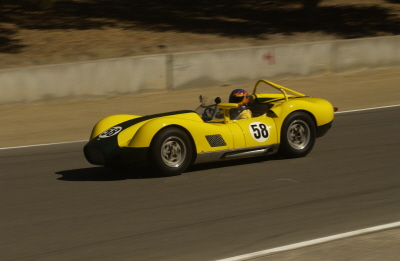 Nikon D1X, 80-200mm f/2.8 AF-S w. TC-14E.
While race cars are fast, unlike birds they
normally move in a straight line.
Nikon D1X, 80-200mm f/2.8 AF-S w. TC-14E.
While race cars are fast, unlike birds they
normally move in a straight line.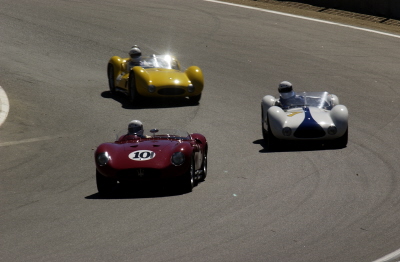 Nikon D1H, 80-200mm f/2.8 AF-S w. TC-14E
Nikon D1H, 80-200mm f/2.8 AF-S w. TC-14E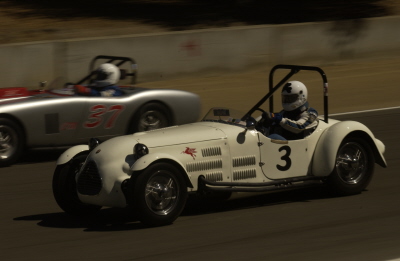 Nikon D1X, 80-200mm f/2.8 AF-S w. TC-14E
Nikon D1X, 80-200mm f/2.8 AF-S w. TC-14E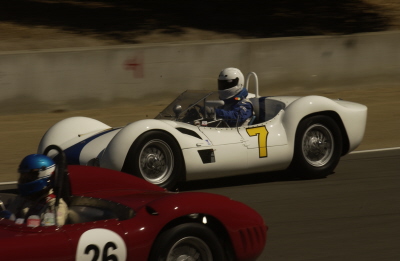 Nikon D1X, 80-200mm f/2.8 AF-S w. TC-14E
Either the D1X or D1H can rip off short bursts
for capturing car to car action.
Nikon D1X, 80-200mm f/2.8 AF-S w. TC-14E
Either the D1X or D1H can rip off short bursts
for capturing car to car action.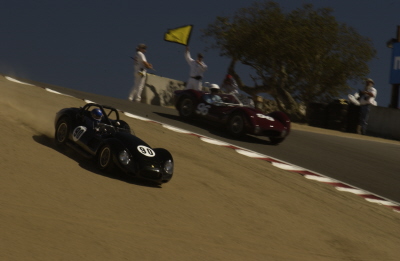 Nikon D1X, 80-200mm f/2.8 AF-S w. TC-14E
For peak action, like when a car goes off the track,
make sure you've got frames left in the buffer.
Nikon D1X, 80-200mm f/2.8 AF-S w. TC-14E
For peak action, like when a car goes off the track,
make sure you've got frames left in the buffer.
